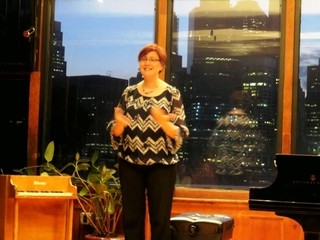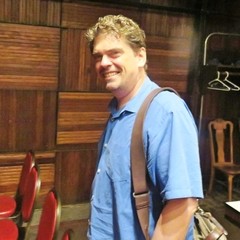|
Back
Edifice Rex New York
BargeMusic
06/24/2016 -
“The Poetry of Places: Newly-written compositions inspired by diverse buildings”
Lewis Spratlan: Bangladesh
Harold Meltzer: In Full Sail
James Matheson: Alone, in Waters Shimmering and Dark (world premiere)
Hannah Lash: Give Me Your Songs
Amy Beth Kirsten: h.o.p.e.
Jack Van Zandt: Sí an Bhrú
Nadia Shpachenko (Pianist) 
N. Shpachenko at BargeMusic (© Samuel A. Dog)
”Music is liquid architecture; Architecture is frozen music.”
Johann Wolfgang von Goethe
Call it picturesque or ironic, but Nadia Shpachenko’s recital devoted to compositions about unique edifices was performed with a background of the world’s most elephantine megaliths. New York’s Financial District creations across the East River were seen clearly through the background triumphs of architectural narcissism and plutocratic egotism.
The six works she played, though, rarely touched these offerings. The sextet of accomplished composers worked with solitary houses on lakeside islands, an anomalous monolith in Dhaka, the world’s oldest extant building, the complex interior of Aaron Copland’s home, and a unique art museum.
How these composers conceived these structures in sound, whether giving them literal measurements or spiritual ideas…that was the challenge of this music, nearly all of it dedicated to Ms. Shpachenko herself.
They couldn’t have chosen a more apt executant. While residing mainly on the West Coast, Ms. Shpachenko has given premieres for Elliott Carter, George Crumb, and virtually every other American composer. Last night, though, Ms. Shpachenko played not only these six very different concepts, but she added a toy piano and–in a beautiful croon–her own voice.
Those two additions were in one of the most intriguing works, Amy Beth Kirsten’s h.o.p.e.. The building was Baltimore’s American Visionary Art Museum, and the event was The Big Hope Show, which “champions the radiant and transformative power of hope.”
How does music show hope? With simplicity. One hand on the Steinway, another hand on the Schoenhut Toy Piano. Sometimes the toy piano was resonance, sometimes counterpoint to the simple tunes on the Steinway. And sometimes, Ms. Shpachenko crooned softly over the two part counterpoint of her two pianos. The result was something magical, a vision which transcended building and, like any art, put us in the mood.
That same beguiling simplicity was in two other works. Hannah Lash is one of my favorite American composers, a woman who can transform music from medieval or modern times, making it totally her own. In exploring Aaron Copland’s home, sited in the hills of upstate New York, she was intrigued not only with the beautiful site but the eccentric interior. Thus, the eccentric transformation of a simple tune in Give Me Your Songs. Perhaps it was a plea to the composer, but it was more her own simple nursery tune, with quite a few “wrong” notes, returning several times during some quasi improvisatory sections on the piano.
The work was always quietly surprising, and at the end, the music seemed to be in honor of Copland himself. A soft American chorale, a few Copland-like harmonies. Never shouted out, but like a soft “Amen”.

J. Matheson (© Samuel A. Dog)
That same homage–and an equal quietness–came in James Matheson’s Alone, in Waters Shimmering and Dark, written for a solitary island on an island in Pine Plains, New York. The homage was in the last movement, written for a memorial service given to his friend and mentor, composer Steven Stucky. The preceding movement was a jazzy toccata, a Bachian virtuoso piece work for Ms. Shpanchenko. But if was the first movement which I found truly original, a work obviously for what Mr. Matheson described as “that fine line between loneliness and its happier sibling, solitude.”
This was a short exercise in silence and sound. A moderately loud moderately dissonant chord, followed by silence…or a few notes. Another chord...more silence...Perhaps the island in the lake, perhaps the house alone. Heard by the person in the house, heard from those on the outside. It was mysterious and touching.
Harold Meltzer celebrated the façade of Frank Gehry’s IAC Building, like his title In Full Sail, a building which gives the appearance of a tall ship going into New York Harbor. This was Meltzer’s celebration of not only the building but the those who see it on the streets.
It was a complex work, not wholly approachable, but always the work of wonderful technician. Rather than attempting to figure it out, I abruptly felt outside the music, like outside the building, taking a walk, examining the various facets, exploring, returning. A pleasant trip indeed.
My prejudice against Lewis Spratlin’s Bangladesh comes because, while Louis Kahn’s building of the Dhaka National Assembly was pretty dynamic, it was equally a waste of money. I knew Bangladesh before that building, poor but gracious. Today the inhabitants of the building are the wicked entrepreneurs of sweatshops, the promoters of savage assassinations, people who use Kahn’s creation to justify turning Bangladesh into their own vassal-state.
Mr. Spratlin, though, celebrated the architecture with a literal five-movement work showing the people, with “energetic local music” (which sounded pentatonically Chinese), then the building itself, the water (a lovely trance-like section), the happy scurrying workers, and “a contemplation of the buildings’ looming presence in the life of Bangladesh.”
It of course means nothing whatsoever to the 95 percent peasants. But we’ll let that go. Apologies for the politics.
The final piece was the most complex, with the most surprising subject. Sí an Bhrú (New Grange) is apparently the oldest extant building in the world, going back to 3200 B.C. I would have opined that honor would go to the Sumerians or Hittites, but this is Ireland’s Boyne Valley. Who knew?
Composer Jack Van Zandt obviously knew, and he celebrated the edifice with a series of variations on a five-note descending scale (more of a cell than a theme). The variations were not simply musical, they were philosophical: a celebration of time itself, of nature, the seasons, of a winter solstice, of a tunnel built beneath the edifice, of an imaginary dance, a tribute to Pierre Boulez in the enigmatic Spirals and Zigzags.
This was, by far, the most demanding work, a piece which demanded utter concentration. Where the other works did their part in conceiving and executing “the poetry of places”, Mr. Van Zandt took place, poetry, music, time and ritual for an adoration which seemed to aim for the illusionary heavenly heights of a a ziggurat in Nineveh.
Harry Rolnick
|